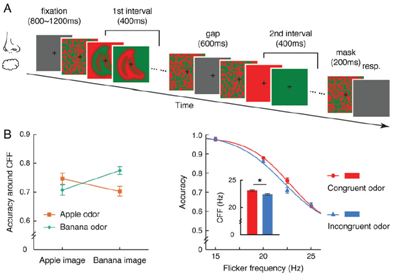The brain is not a timepiece. Whereas it is equipped with senses like vision, audition, touch, smell, and taste, it has no direct access to or measure of the physical time (unless you read from a clock). Rather, it constructs the subjective “time” of an event from the dynamic multisensory inputs associated with that event. Yet different senses come with different temporal precisions. For instance, when standing near an apple tree, you can detect the falling of an apple much better with your eyes or ears than the nose. How does the brain coordinate multisensory signals entering different brain regions with different temporal resolutions, and come up with the subjective time?
A team at the Institute of Psychology at Chinese Academy of Sciences tackled this issue using odors and images. Specifically, Dr. Bin Zhou, the study’s lead author, and his colleagues examined whether odors could modulate one’s temporal sampling and subjective duration of visual objects. In their study, participants viewed two series of flickering isoluminant images in red and green (Figure 1A). One of the series contained opposite images of an apple or bananas; the other contained only images of red and green fields. When the images alternated at a frequency beyond 20 Hz, the participants started to have difficulty reporting which series contained an object. Indeed, for most people, chromatic flicker fusion frequency (CFF), the limit at which alternating colors become perceived as a stable fused color, falls somewhere between 20 and 25 Hz. Interestingly, the participants’ object detection accuracies around CFF were improved under the exposure of a congruent, as opposed to an incongruent, odor. In other words, the participants detected a rapidly flickering apple better when they smelled an apple odor rather than a banana odor, and vice versa (Figure 1B, left panel). In effect, the presence of a congruent odor facilitated the brain’s temporal sampling of a visual object and elevated its CFF (Figure 1B, right panel). Based on electrical activities recorded from the participants’ scalp, the researchers found that the integration between smell and vision strengthened the signals of the corresponding object in a brain region heavily implicated in object representations called the right temporal cortex, about 150-300 ms after object onset. They further showed that such integration lengthened one’s subjective duration of the corresponding object in a duration comparison task. The researchers concluded that subjective time is warped by the neural energy involved in representing multisensory inputs at subsecond scales.

Figure A :Participants viewed two series of flickering isoluminant images in red and green;
Figure B :A congruent odor facilitated the brain’s temporal sampling of a visual object and elevated its CFF
The study recently appeared online in the journal Cerebral Cortex:
Contact:
ZHOU Wen
Institute of Psychology, Chinese Academy of Sciences
zhouw@psych.ac.cn
